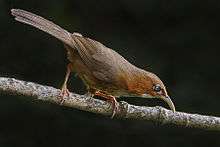Rusty-cheeked scimitar babbler
The rusty-cheeked scimitar babbler (Erythrogenys erythrogenys) is a species of bird in the family Timaliidae native to South-East Asia.
| Rusty-cheeked scimitar babbler | |
|---|---|
 | |
| E. e. erythrogenys, Ghatgarh, Nainital, Uttarakhand, India. | |
| Scientific classification | |
| Kingdom: | Animalia |
| Phylum: | Chordata |
| Class: | Aves |
| Order: | Passeriformes |
| Family: | Timaliidae |
| Genus: | Erythrogenys |
| Species: | E. erythrogenys |
| Binomial name | |
| Erythrogenys erythrogenys Vigors, 1832 | |
Subspecies
Erythrogenys erythrogenys has a number of recognized subspecies:[2]
- E. e. erythrogenys (northwest Himalayas)
- E. e. imberbis
- E. e. haringtoni
- E. e. gravivox
- E. e. macclellandi
- E. e. ferrugilatus (central Himalayas from Nepal to Bhutan)
- E. e. imberbis (east Myanmar)
- E. e. celata (east Myanmar and northeast Thailand)
Description
The species is olive-brown above with rusty coluring on the sides of the face, head, thighs, and flanks. The belly is mostly white. Sexes are alike. The beak is long and decurved in a scimitar shape.[2]
Distribution and habitat
The rusty-cheeked scimitar babbler is found from the Himalayas to Myanmar. It inhabits habitats are subtropical or tropical moist lowland forest and subtropical or tropical moist montane forest at elevations up to 2600 m.[1]
Ecology
The bird feeds mostly on the forest floor and in low canopy, forming small groups. Food items include insects, grubs and seeds. Calls consist of a mellow, fluty whistle, a two-noted "CUE..PE...CUE..pe" call followed by single note replay by mate, guttural alarm calls and a liquid contact note. The species is generally quite noisy.[1][2]
References
- BirdLife International (2012). "Erythrogenys erythrogenys". IUCN Red List of Threatened Species. 2012. Retrieved 26 November 2013.CS1 maint: ref=harv (link)
- Baker, Edward Charles Stuart (1922). The Fauna of British India, including Ceylon and Burma (Birds Vol 1). Taylor and Francis. pp. 219–222.
Further reading
- Collar, N. J. & Robson, C. 2007. Family Timaliidae (Babblers) pp. 70 – 291 in; del Hoyo, J., Elliott, A. & Christie, D.A. eds. Handbook of the Birds of the World, Vol. 12. Picathartes to Tits and Chickadees. Lynx Edicions, Barcelona.

_Nagarjun.jpg)